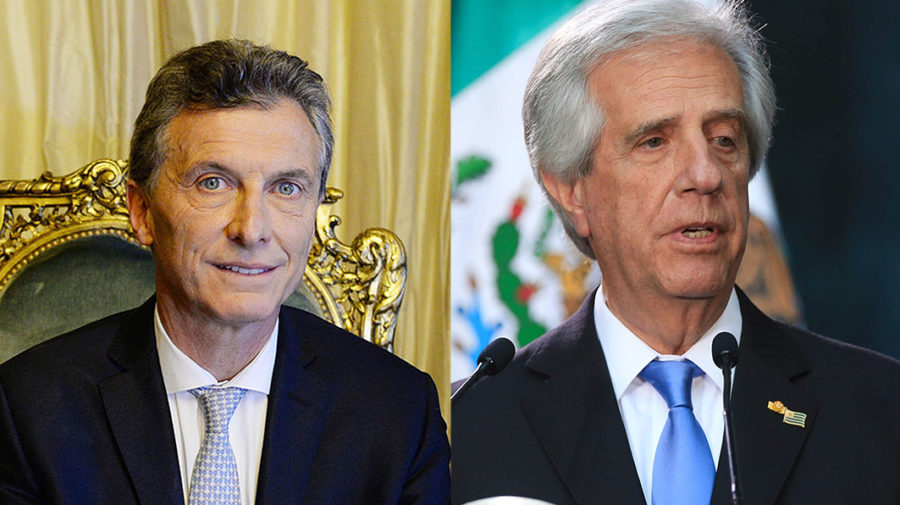After two hotly-contested election campaigns, voters in Uruguay and Argentina will head to the polls on Sunday to vote for new presidents. The election cycles have seen the two countries peppered with mis- and disinformation, which has spread across a range of different social media platforms, including Facebook, Twitter and WhatsApp.
From electoral misinformation and misleading memes to false articles and the weaponisation of context – an increasingly popular and hard-to-debunk tactic which reframes genuine content – Argentina and Uruguay have experienced the gamut of disinformation.
Disinformation techniques used in the United States, such as the doctored video of Nancy Pelosi, were replicated in Argentina to target the Minister of Security Patricia Bullrich. Some of the falsehoods spread in Uruguay were even amplified by journalists in other countries, underlying the importance of verification techniques and media literacy.
Talking with experts in both countries, including members of Reverso and Verificado – two First Draft collaborative newsroom initiatives tackling disinformation in Argentina and Uruguay – we outline below some of the most common trends around disinformation that have beset both countries during their election cycles. (Presidents Tabaré Vázquez of Uruguay and Mauricio Macri of Argentina are the incumbents attempting to remain in power).
The weaponisation of context
The use of genuine content that is “warped and reframed” is increasingly being employed as a disinformation tactic around the world. Not only is this kind of content more engaging and persuasive because it is based on real content — often a real video or a photo from a different country or a different year — but it is also less likely to get picked up by the more advanced AI systems used by some fact-checking operations. In Argentina, misconstruing genuine content is a widely implemented strategy.
“On social media the most used [disinformation] tactics are the publication of photos and quotes taken out of context,” said Laura Zommer, executive director at Chequeado, who is also the editorial director at Reverso.
Some of the more “well-organised” instances of this kind of disinformation which were used to confuse the public came in the form of videos showing ballot irregularities during the midterm elections.
While the videos were real, they “didn’t show that there was actual fraud because at that point they didn’t have any legal value,” said Zommer. Nonetheless these videos were shared widely and leveraged as evidence (albeit false) of wide scale ballot fraud.
Whether they are audio files, photos, quotes, or videos, there are many ways that real information can be altered in order to depict or induce a false interpretation. For example, a photo of a woman holding a baby as she was allegedly working for a bike delivery service was used by public figures, congressmen and even a presidential candidate to talk about job insecurity in Argentina.
After some collaborative and investigative work, Reverso revealed that the Venezuelan lady, living in Buenos Aires since 2018, had been leaving her daughter in a kindergarten before going to work. Meanwhile, the person who took the photo confirmed that he did not see her riding the bike parked beside her in the image.
The role of WhatsApp
The role of WhatsApp as a source and also as a key driver of disinformation seems to be increasing around the world. This has been underlined by nearby countries such as Brazil where the messaging service was used widely to spread misinformation around the election in 2018. In India, WhatsApp has been connected with a string of lynchings and murders.
While Facebook and Twitter continue to play large roles as distribution points for mis- and disinformation in Argentina and Uruguay, WhatsApp has featured as a significant facilitator of falsehoods in both countries.
Because disinformation often crisscrosses between platforms, making it difficult to measure where it starts, according to Zommer, experts in Argentina couldn’t pinpoint which particular platform was the principal driver of disinformation.
But in Uruguay, WhatsApp was “the chief conduit of disinformation followed by Facebook”, according to Sebastian Auyanet, a journalist participating in Verificado.
For Elodie Martínez, coordinator of AFP Factual in Spanish and AFP Checamos in Portuguese, combatting disinformation on WhatsApp was a major challenge in both countries because the “messaging service makes it much harder to get to the origin and author of the disinformation” which is easier with other platforms such as Twitter and Facebook.
Power of the memes
Hyper-partisan and misleading memes have been used widely in elections around the world, including the 2016 US election, where anti-Hillary memes were rife on social media and semi-closed platforms such as 4chan.
This also happened in the 2018 Brazilian election, where memes opposing the PT (the Worker’s Party) – the main opposition to Jair Bolsonaro – were widely shared. While it is difficult to quantify the effects of memes on a population, experts believe that the “drip drip drip” of these hyper-partisan memes, many of which support instances of disinformation, can impact voters’ opinions.
Misleading memes were a key disinformation strategy in Argentina and were the most popular form of disinformation in Uruguay, according to Auyanet, who points out that “many people take a meme as real information”.
Part of why they are so common in both countries is because they are easy to produce and rig, according to Zommer.
Audio
The use of audio files have also been increasingly used as a disinformation strategy, especially in Argentina, where they have featured on WhatsApp. The authenticity of audio files are notoriously difficult to verify because it requires corroborating the voices that are ostensibly being portrayed on the recording.
One of the biggest challenges to Reverso’s fact-checking efforts, according to Zommer, has been this kind of verification. Nonetheless, with the help of the National Scientific and Technical Research Council in Argentina (CONICET) – which has developed a tool for the forensic analysis of audio files – Reverso has managed to debunk the most important cases of audio disinformation.
Politicians as a source of disinformation
Disinformation is not only spread by political supporters and their networks, of course, but also by public officials and candidates. According to Eugenia Mitchelstein, researcher at San Andres University in Argentina, “in politics, disinformation circulates and is spread majorly by the politicians themselves, who lie, and to a lesser extent, share [dis]information disseminated on social networks”.
Even after a detailed verification, it is still difficult to get those who spread misinformation to admit the error, according to Adriana Amado, executive president at Info Ciudadana.
“People continue to spread the erroneous version,” said Amado, pointing out how they even accuse the verification teams of changing the facts.
Conclusion
The recent election cycles in Argentina and Uruguay show how disinformation are not just evolving in the US and Europe but across the world. Doctored videos and material taken out of context – a class of information that can be difficult to debunk – feature alongside more classic cases of disinformation, such as misleading memes and bogus articles.
Much of this content surfaced on Facebook and Twitter, but much of it also spread across WhatsApp, highlighting the growing role of the closed messaging service in disseminating falsehoods, similar to what has been seen in other countries such as India and Brazil.
In both Argentina and Uruguay, as in much of the world, the polarisation of political debates has facilitated the spread of disinformation.
“Disinformation is the symptom and the tool of fanaticism,” said Amado.
Stay up to date with First Draft’s work by becoming a subscriber and following us on Facebook and Twitter.






